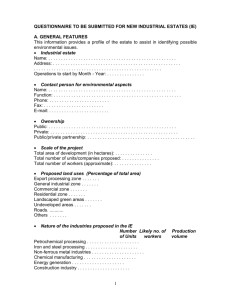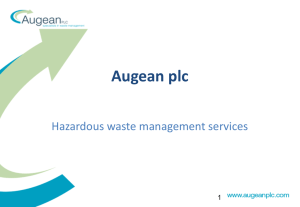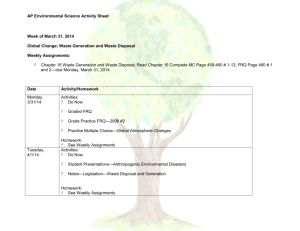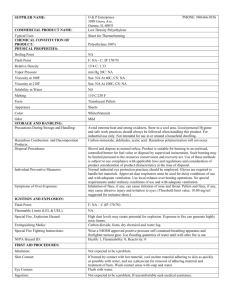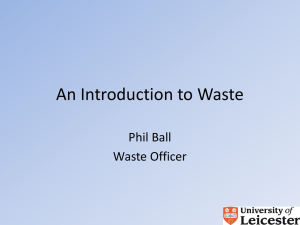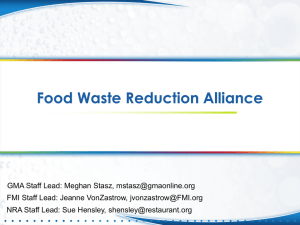09. Radiation Protection Considerations During the Operational and
advertisement
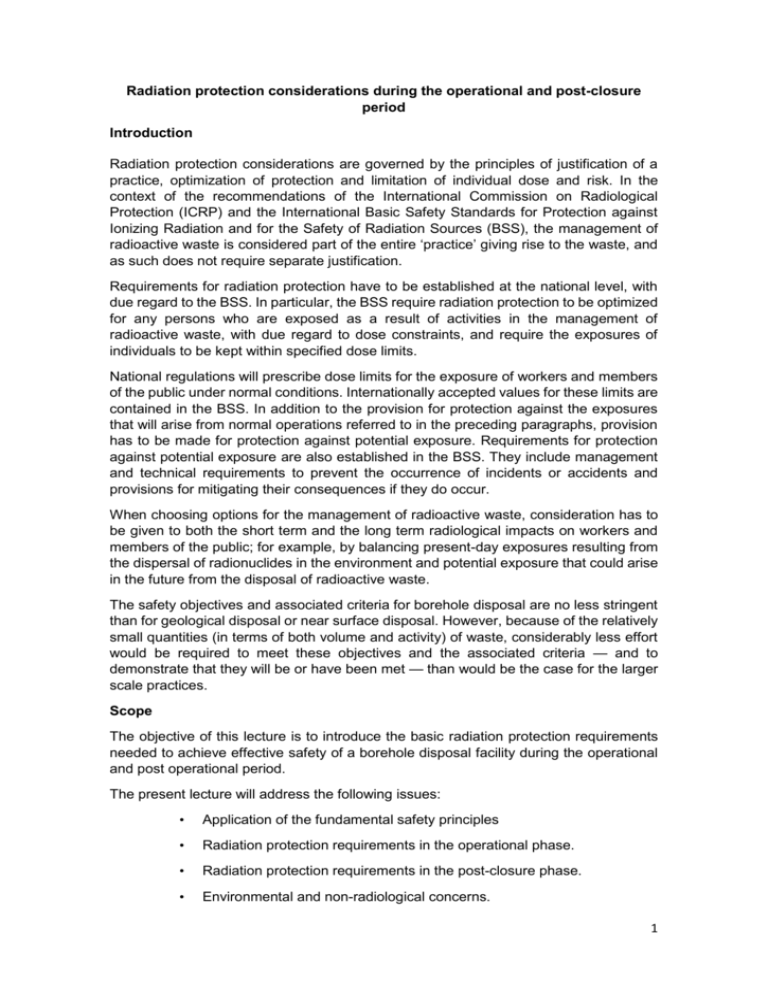
Radiation protection considerations during the operational and post-closure period Introduction Radiation protection considerations are governed by the principles of justification of a practice, optimization of protection and limitation of individual dose and risk. In the context of the recommendations of the International Commission on Radiological Protection (ICRP) and the International Basic Safety Standards for Protection against Ionizing Radiation and for the Safety of Radiation Sources (BSS), the management of radioactive waste is considered part of the entire ‘practice’ giving rise to the waste, and as such does not require separate justification. Requirements for radiation protection have to be established at the national level, with due regard to the BSS. In particular, the BSS require radiation protection to be optimized for any persons who are exposed as a result of activities in the management of radioactive waste, with due regard to dose constraints, and require the exposures of individuals to be kept within specified dose limits. National regulations will prescribe dose limits for the exposure of workers and members of the public under normal conditions. Internationally accepted values for these limits are contained in the BSS. In addition to the provision for protection against the exposures that will arise from normal operations referred to in the preceding paragraphs, provision has to be made for protection against potential exposure. Requirements for protection against potential exposure are also established in the BSS. They include management and technical requirements to prevent the occurrence of incidents or accidents and provisions for mitigating their consequences if they do occur. When choosing options for the management of radioactive waste, consideration has to be given to both the short term and the long term radiological impacts on workers and members of the public; for example, by balancing present-day exposures resulting from the dispersal of radionuclides in the environment and potential exposure that could arise in the future from the disposal of radioactive waste. The safety objectives and associated criteria for borehole disposal are no less stringent than for geological disposal or near surface disposal. However, because of the relatively small quantities (in terms of both volume and activity) of waste, considerably less effort would be required to meet these objectives and the associated criteria — and to demonstrate that they will be or have been met — than would be the case for the larger scale practices. Scope The objective of this lecture is to introduce the basic radiation protection requirements needed to achieve effective safety of a borehole disposal facility during the operational and post operational period. The present lecture will address the following issues: • Application of the fundamental safety principles • Radiation protection requirements in the operational phase. • Radiation protection requirements in the post-closure phase. • Environmental and non-radiological concerns. 1 Definitions The terms used in this publication have the meanings ascribed to them in the IAEA Safety Glossary, 2007 Edition [2], where applicable. Application of the fundamental safety principles The IAEA Safety Fundamentals publication Fundamental Safety Principles sets out the fundamental safety objective and safety principles that apply for all facilities and activities in radioactive waste management, including the disposal of radioactive waste. The fundamental safety objective is to protect people and the environment from harmful effects of ionizing radiation. The strategy adopted at present to achieve this fundamental safety objective in respect of the disposal of radioactive waste is to contain the waste and to isolate it from the accessible biosphere, to the extent that this is necessary. The biosphere is that part of the environment that is normally inhabited by living organisms, and in the Safety Requirements for Disposal [SSR 5] the ‘accessible biosphere’ is taken generally to include those elements of the environment, including groundwater, surface water and marine resources, that are used by people or accessible to people. The accessible biosphere is, therefore, that part of the environment that the objective, criteria and requirements set out in the Safety Requirements publication [SSR 5] are established to protect. By applying the strategy of containment and isolation of waste, it is implicit that if waste were to be disturbed after its disposal in a facility, then radiation doses might be incurred. Disposal facilities are to be developed in such a way that people and the environment are protected both now and in the future (SF-1, Principle 7). In this regard, the prime consideration is the radiological hazard presented by radioactive waste. The ICRP developed the System of Radiological Protection that applies to all facilities and activities, and this system was adopted in the International Basic Safety Standards. The ICRP has elaborated the application of the System of Radiological Protection to the disposal of solid radioactive waste in its Publications 77 and 81, which it reconfirmed in Publication 103. This provides a starting point for the safety considerations discussed here in relation to disposal facilities. The safety objective and criteria set out in this section apply regardless of national boundaries. Transboundary issues are dealt with in the framework of existing conventions, treaties and bilateral agreements. Particular specific obligations apply to Contracting Parties to the Joint Convention on the Safety of Spent Fuel Management and on the Safety of Radioactive Waste Management [2]. Radiation protection requirements in the operational phase The radiation safety requirements and the related safety criteria for the operational period of a disposal facility are the same that apply for any nuclear facility or activity involving radioactive material in the case of planned exposure situations and are established in the International Basic Safety Standards. Disposal facilities receiving waste from nuclear fuel cycle facilities will generally be licensed nuclear facilities and have to operate under the terms of a facility licence. Disposal facilities for small quantities of waste (e.g. borehole facilities) may not be regarded as nuclear facilities in some States but have to be subject to an appropriate regulatory process and have to be licensed accordingly. In radiation safety terms, the disposal facility is considered to be a source of radiation that is under regulatory control in a planned exposure situation. In the operational period, any radioactive release can be verified, exposures can be controlled and actions can be 2 taken if necessary. The engineering means and practical means of achieving safety are well known, although their use in a disposal facility involves specific considerations. The primary goal is to ensure that radiation doses are as low as reasonably achievable and within the applicable system of dose limitation. The optimization of protection (that is, the process of determining measures for protection and safety to make exposures, and the probability and magnitude of potential exposures, “as low as reasonably achievable, economic and social factors being taken into account”) is considered in the design of the disposal facility and in the planning of all operations. Relevant considerations in the optimization of measures for protection and safety include: the separation of mining and construction activities from waste emplacement activities; the use of remote handling equipment and shielded equipment for waste emplacement, where necessary; the control of the working environment so as to reduce the potential for accidents and their potential consequences; and the minimization of the need for maintenance in supervised areas and controlled areas. Contamination is required to be controlled and prevented to the extent possible. No releases of radionuclides, or only very minor releases (such as small amounts of gaseous radionuclides), may be expected during the normal operation of a radioactive waste disposal facility and hence there will not be any significant doses to members of the public. Even in the event of an accident involving the breach of a waste package on the site of a disposal facility, releases are unlikely to have any radiological consequences outside the facility. A radiological protection programme should be in place during the operational period. This should ensure that doses to workers are controlled and that the requirements for dose limitation are met. In addition, contingency measures should be in place to deal with accidents and incidents so that any associated radiation hazards are controlled to the extent possible. The absence of radiological consequences of any significance outside the facility would be confirmed by means of safety assessment. Relevant considerations include the waste form (i.e. the packaging and the radionuclide content of the waste), the control of contamination on waste packages and equipment, and the monitoring and control of drainage water from the disposal facility, where applicable, and of the ventilation exhaust air from underground disposal facilities. For a disposal facility, as for any other operational nuclear facility or facility where radioactive material is handled, used, stored or processed, an operational radiation protection programme, commensurate with the radiological hazards, is required to be put in place to ensure that doses to workers during normal operations are controlled and that the requirements for the limitation of radiation doses are met. In addition, emergency plans are required to be put in place for dealing with accidents and other incidents, and for ensuring that any consequent radiation doses are controlled to the extent possible, with due regard for the relevant emergency action levels. The doses and risks associated with the transport of radioactive waste through public areas to a disposal facility are required to be managed in the same way as the doses and risks associated with the transport of other radioactive material. The transport of radioactive waste is subject to the requirements of the IAEA’s Regulations for the Safe Transport of Radioactive Material. 3 Radiation protection requirements in the post-closure phase The safety objective and criteria for the protection of people and the environment after closure of a disposal facility are as follows: Safety objective The safety objective is to site, design, construct, operate and close a disposal facility so that protection after its closure is optimized, social and economic factors being taken into account. A reasonable assurance also has to be provided that doses and risks to members of the public in the long term will not exceed the dose constraints or risk constraints that were used as design criteria. Criteria (a) The dose limit for members of the public for doses from all planned exposure situations is an effective dose of 1 mSv in a year. This and its risk equivalent are considered criteria that are not to be exceeded in the future. (b) To comply with this dose limit, a disposal facility (considered as a single source) is so designed that the calculated dose or risk to the representative person who might be exposed in the future as a result of possible natural processes3 affecting the disposal facility does not exceed a dose constraint of 0.3 mSv in a year or a risk constraint of the order of 10–5 per year. (c) In relation to the effects of inadvertent human intrusion after closure, if such intrusion is expected to lead to an annual dose of less than 1 mSv to those living around the site, then efforts to reduce the probability of intrusion or to limit its consequences are not warranted. (d) If human intrusion were expected to lead to a possible annual dose of more than 20 mSv to those living around the site, then alternative options for waste disposal are to be considered, for example, disposal of the waste below the surface, or separation of the radionuclide content giving rise to the higher dose. (e) If annual doses in the range 1–20 mSv are indicated, then reasonable efforts are warranted at the stage of development of the facility to reduce the probability of intrusion or to limit its consequences by means of optimization of the facility’s design. (f) Similar considerations apply where the relevant thresholds for deterministic effects in organs may be exceeded. The primary goal of borehole disposal is to dispose of radioactive waste in a manner that protects human health and the environment in the long term, after the borehole disposal facility has been closed. In accordance with the BSS, this is achieved by means of design features that result in optimizing doses due to any migration of radionuclides from the facility while also complying with the dose constraints. It is recognized, however, that radiation doses and risks to individuals living in the distant future can only be estimated and the reliability of these estimates will decrease as the time period extending into the future increases. In this context, the optimization of protection is a judgemental process in which social and economic factors need to be taken into account, and it needs to be conducted in a structured but essentially qualitative way, supported by quantitative analysis. A well-designed and well-located borehole disposal facility should provide reasonable assurance that radiological impacts in the post-closure period will be low both in absolute terms and in comparison with any other waste management options that are 4 currently available at reasonable cost. A site should be identified that provides favourable conditions for containment and isolation of the waste from the biosphere and for preservation of the engineered barriers (e.g. with low groundwater flow and a benign geochemical environment). The borehole disposal facility should be designed to take account of the characteristics offered by the site, to optimize protection and to keep doses within the dose and/or risk constraints. The borehole disposal facility should then be constructed, operated and closed according to the assessed design so that the assumed safety characteristics of both the engineered and the natural barriers are realized. It is recognized that radiation doses to people in the future can only be estimated and that uncertainties associated with these estimates will increase for periods farther into the future. Caution needs to be exercised in applying criteria for periods far into the future. Beyond such timescales, the uncertainties associated with dose estimates become so large that the criteria might no longer serve as a reasonable basis for decision making. The primary goal of the disposal of radioactive waste is the protection of people and the environment in the long term, after the disposal facility has been closed. In this period, migration of radionuclides to the accessible biosphere, dispersion of radionuclides into the accessible biosphere and the consequent exposure of people may occur. This is a consequence of the slow degradation of engineered components and the slow transport of radionuclides from the facility by natural processes. Discrete events may lead to an earlier or greater release. Such events could be of either natural or human origin. Optimization under constraints is the central approach adopted to ensure the safety of a waste disposal facility. In this context, the optimization of protection is a judgemental process, social and economic factors being taken into account. The optimization is conducted in a structured but essentially qualitative manner, supported by quantitative analysis. Different methods may be used to assess the impacts of the disposal of radioactive waste after closure of the disposal facility and to demonstrate compliance with national regulations expressed as constraints in terms of levels of dose and/or risk. This matter is addressed in the Safety Guide on the safety case and safety assessment for disposal. Evaluating whether or not the design will provide an optimized level of protection may require a judgement in which other factors will be considered. These factors may include, for example, the quality of the design and of the assessment and the presence of significant qualitative or quantitative uncertainties in the calculation of long term exposures. In general, when irreducible uncertainties make the results of safety assessment calculations less reliable, then comparison with dose or risk constraints should be treated with caution. For a borehole disposal facility, such circumstances are likely to apply when considering: (a) Design evolution at very distant times in the future; (b) Very low frequency natural events; (c) Human intrusion events. Very low frequency natural events could degrade the borehole disposal facility barriers, leading to the release of radionuclides to the environment and the exposure of humans to radiation. In circumstances where there is a significant uncertainty associated with the occurrence of an event or process and the consequent exposures, the level of safety is best demonstrated by separate consideration of the probability of occurrence and the potential magnitude of exposures. In these situations, the treatment of exposures far into the future is considered conceptually similar to potential exposure situations and can be 5 treated in a similar manner. Again, as far as boreholes are concerned, the relatively short half-life of typical waste envisaged for disposal and the consequently shorter assessment time frame will tend to diminish the significance of very low frequency natural events. In the event of inadvertent human intrusion into a borehole disposal facility, a few individuals who take part in activities such as drilling or excavating into the facility could receive high doses. The doses and risks to these individuals should be estimated but, according to the latest ICRP recommendations, they need not be a deciding factor in assessing the safety and acceptability of the facility. The doses and consequences of such intrusion should be estimated in order to evaluate and determine the appropriate measures (administrative and physical) necessary to prevent intrusion or to mitigate its consequences. Once it is determined that the disposal system includes appropriate deterrents to intrusion commensurate with the safety requirements and the potential consequences of such intrusion, the dose estimates for an intruder need not be used further. The borehole disposal system has a number of inherent features that reduce the likelihood and the consequences of intrusion. These include: (a) The low probability of occurrence; (b) The fact that the individuals would be few in number; (c) The possibility for such individuals to receive appropriate decontamination and medical treatment; (d) The fact that such hazards may be comparable with other occupational risks; (e) The possibility that, while doses received due to inadvertent intrusion could be high, the associated risk may be outweighed by the higher level of long term protection afforded by borehole disposal, in comparison with other strategies. A more significant consequence of intrusion is the possibility that it could disrupt the engineered barriers and cause long term harmful consequences for people living in the vicinity of the borehole. In this case, protection is best achieved by means of efforts to reduce the probability of such events. One option is to assess the consequences of human intrusion, for which one or two stylized human intrusion scenarios should be evaluated using the criteria described above]. Other approaches to assessing the consequences of human intrusion may also be acceptable. The small ‘footprint’ of a borehole disposal facility will help to reduce the probability of human intrusion and this can be reduced still further by increasing the depth and length of the disposal zone. Siting of the facility away from known mineral and water resources will also decrease the likelihood of human intrusion. Over shorter timescales, actions such as preserving records, placing restrictions on land use, placing warning signs and maintaining passive institutional control should also help to reduce the incidence of such events. Environmental and non-radiological concerns The assessment of conventional environmental impacts such as may occur in the construction and operational periods of a disposal facility, for example, impacts relating to traffic, noise, visual amenity, disturbance of natural habitats, restrictions on land use and social and economic factors, is outside the scope of this Safety Requirements publication. This Safety Requirements publication covers the protection of the environment against radiological hazards associated with the radioactive material in the disposal facility. The non-radiological toxic hazard also has to be assessed where this is significant, as discussed in the following paragraphs. For the purposes of the current recommendations of the ICRP and the requirements of the International Basic Safety Standards, it is assumed that, subject to the appropriate definition of exposed groups, the protection of people against the radiological hazards 6 associated with a disposal facility will also apply the principle of protecting the environment. The issue of the protection of the environment from harmful effects of ionizing radiation and the development of standards for this purpose are under discussion internationally. Estimates of possible doses and/or risks due to the future migration of radionuclides from a disposal facility are indicators of the protection of people. On the basis of the assumption mentioned before, calculations to estimate doses in which account is taken of a range of possible environmental transfer pathways could already be considered to be indicators of environmental protection. Additional indicators and comparisons, such as estimates of concentrations and fluxes of contaminants and their comparison with concentrations and fluxes of radionuclides of natural origin within the geosphere or biosphere, may also prove valuable in indicating a level of overall environmental protection that is independent of assumptions about the habits of people. Other factors to be considered may include the need for protection of groundwater resources and the ecological sensitivity of the environment into which contaminants might be released. The impact of non-radioactive material present in a disposal facility has to be assessed in accordance with national or other specific regulations and this may be significant in some cases, for example, for some mining wastes and mixtures of radioactive and toxic wastes. If non-radioactive material may affect the release and migration of radioactive contaminants from the radioactive waste, then such interactions have to be considered in the safety assessment. The impact of non-radioactive materials present in a borehole disposal facility should also be assessed. Factors that should be considered may include the content of chemically or biologically toxic materials in the waste or in the engineered barrier materials, the protection of groundwater resources and the ecological sensitivity of the environment into which contaminants may be released. For example, if disused sealed sources were to be disposed of together with their lead shielding, safety assessments would need to examine the potential migration of the lead. Questions and Answers 1. Do radiation dose limits and constraints for workers and for members of the public that are set out in the Basic Safety Standards for planned exposure situations apply also for the operational phase of a borehole facility? 2. Which of the following criteria need to be considered in the long terma safety assessment for borehole facilities: Correct X X X Choice The dose limit for members of the public for doses from all planned exposure situations is an effective dose of 1 mSv in a year To comply with this dose limit, a disposal facility (considered as a single source) is so designed that the calculated dose or risk to the representative person who might be exposed in the future as a result of possible natural processes3 affecting the disposal facility does not exceed a dose constraint of 0.3 mSv in a year In relation to the effects of inadvertent human intrusion after closure, if such intrusion is expected to lead to an annual dose of less than 1 mSv to those 7 living around the site, then efforts to reduce the probability of intrusion or to limit its consequences are not warranted. If human intrusion were expected to lead to a possible annual dose of more than 20 mSv to those living around the site, then alternative options for waste disposal are to be considered, for example, disposal of the waste below the surface, or separation of the radionuclide content giving rise to the higher dose. If annual doses in the range 1–20 mSv are indicated, then reasonable efforts are warranted at the stage of development of the facility to reduce the probability of intrusion or to limit its consequences by means of optimization of the facility’s design. X X 3. The borehole disposal system has a number of inherent features that reduce the likelihood and the consequences of intrusion. These include: Correct X X X X Choice The low probability of occurrence The fact that the individuals would be few in number The possibility for such individuals to receive appropriate decontamination and medical treatment The possibility that, while doses received due to inadvertent intrusion could be high, the associated risk may be outweighed by the higher level of long term protection afforded by borehole disposal, in comparison with other strategies The fence around the borehole References [1] EUROPEAN ATOMIC ENERGY COMMUNITY, FOOD AND AGRICULTURE ORGANIZATION OF THE UNITED NATIONS, INTERNATIONAL ATOMIC ENERGY AGENCY, INTERNATIONAL LABOUR ORGANIZATION, INTERNATIONAL MARITIME ORGANIZATION, OECD NUCLEAR ENERGY AGENCY, PAN AMERICAN HEALTH ORGANIZATION, UNITED NATIONS ENVIRONMENT PROGRAMME, WORLD HEALTH ORGANIZATION, Fundamental Safety Principles, IAEA Safety Standards Series No. SF-1, IAEA, Vienna (2006). [2] Joint Convention on the Safety of Spent Fuel Management and on the Safety of Radioactive Waste Management, INFCIRC/546, IAEA, Vienna (1997). [3] FOOD AND AGRICULTURE ORGANIZATION OF THE UNITED NATIONS, INTERNATIONAL ATOMIC ENERGY AGENCY, INTERNATIONAL LABOUR ORGANISATION, OECD NUCLEAR ENERGY AGENCY, PAN AMERICAN HEALTH ORGANIZATION, WORLD HEALTH ORGANIZATION, International Basic Safety Standards for Protection against Ionizing Radiation and for the Safety of Radiation Sources, Safety Series No. 115, IAEA, Vienna (1996) (under revision). 8 [4] INTERNATIONAL COMMISSION ON RADIOLOGICAL PROTECTION, 1990 Recommendations of the International Commission on Radiological Protection, Publication 60, Pergamon Press, Oxford and New York (1991). [5] INTERNATIONAL COMMISSION ON RADIOLOGICAL PROTECTION, Radiological Protection Policy for the Disposal of Radioactive Waste, Publication 77, Pergamon Press, Oxford and New York (1997). [6] INTERNATIONAL COMMISSION ON RADIOLOGICAL PROTECTION, Radiation Protection Recommendations as Applied to the Disposal of Long-lived Solid Radioactive Waste, Publication 81, Pergamon Press, Oxford and New York (1998). [7] INTERNATIONAL COMMISSION ON RADIOLOGICAL PROTECTION, The 2007 Recommendations of the International Commission on Radiological Protection, Publication 103, Elsevier (2007). [8] INTERNATIONAL ATOMIC ENERGY AGENCY, Regulatory Control of Radioactive Discharges to the Environment, IAEA Safety Standards Series No. WS-G- 2.3, IAEA, Vienna (2000). [9] INTERNATIONAL ATOMIC ENERGY AGENCY, Application of the Concepts of Exclusion, Exemption and Clearance, IAEA Safety Standards Series No. RS-G1.7, IAEA, Vienna (2004). [10] INTERNATIONAL ATOMIC ENERGY AGENCY, IAEA Safety Glossary: Terminology Used in Nuclear Safety and Radiation Protection, 2007 Edition, IAEA, Vienna (2007). [11] INTERNATIONAL ATOMIC ENERGY AGENCY, Storage of Radioactive Waste,IAEA Safety Standards Series No. WS-G-6.1, IAEA, Vienna (2006). [12] INTERNATIONAL ATOMIC ENERGY AGENCY, Classification of Radioactive Waste, IAEA Safety Standards Series No. GSG-1, IAEA, Vienna (2009). [13] INTERNATIONAL ATOMIC ENERGY AGENCY, The Management System for Facilities and Activities, IAEA Safety Standards Series No. GS-R-3, IAEA, Vienna (2006). [14] INTERNATIONAL ATOMIC ENERGY AGENCY, The Management System for the Disposal of Radioactive Waste, IAEA Safety Standards Series No. GS-G-3.4, IAEA, Vienna (2008). [15] INTERNATIONAL ATOMIC ENERGY AGENCY, INTERNATIONAL LABOUR OFFICE, Occupational Radiation Protection, IAEA Safety Standards Series No. RS-G-1.1, IAEA, Vienna (1999). [16] FOOD AND AGRICULTURE ORGANIZATION OF THE UNITED NATIONS, INTERNATIONAL ATOMIC ENERGY AGENCY, INTERNATIONAL LABOUR ORGANIZATION, OECD NUCLEAR ENERGY AGENCY, PAN AMERICAN HEALTH ORGANIZATION, UNITED NATIONS OFFICE FOR THE COORDINATION OF HUMANITARIAN AFFAIRS, WORLD HEALTH 9 ORGANIZATION, Preparedness and Response for a Nuclear or Radiological Emergency, IAEA Safety Standards Series No. GS-R-2, IAEA, Vienna (2002). [17] INTERNATIONAL ATOMIC ENERGY AGENCY, Regulations for the Safe Transport of Radioactive Material, 2009 Edition, IAEA Safety Standards Series No. TS-R-1, IAEA, Vienna (2009). 10

